The 32 S&W cartridge dates back to the late 1870s, and the 32 S&W Long is slightly newer. It was introduced in the late 1890s. This round took the same route as the 38- and 44-caliber cartridges. Shooters wanted more power, so the cartridge case was lengthened to add more powder. In 1984, Harrington & Richardson (H&R) partnered with Federal and lengthened the 32 S&W Long case and called it the 32 H&R Magnum. This cartridge offers low recoil with energy levels similar to a 38 Special. The advantage of 32 H&R Magnum over the 38 Special was the former holds six shots compared to the latter, which holds five shots in the same size revolver. The 32 H&R Magnum nearly succumbed and became a mere footnote in Cartridges Of The World. In 2008, Federal increased the case length again and introduced the 327 Federal Magnum which was intended to provide similar ballistics as the 357 Magnum; again the advantage is more round capacity with the 32 Federal Magnum compared to the 357 Magnum in the same-size revolver. Plus, there is less recoil with the 32 Federal Magnum. If you think the 327 Federal Magnum is ballistically the same as a 357 Magnum, then we have a bridge in Brooklyn we’d like to sell you.
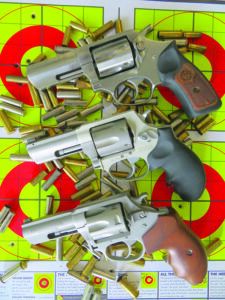 We wanted to take a look at the 32 Magnums and compare them to the 38 Special in revolvers of similar size. The three revolvers we acquired included a Ruger SP101 in 327 Federal Magnum, a Charter Arms Professional in 32 H&R Magnum, and a Taurus 856 Defender in 38 Special. In our opinion, the Charter Arms Professional offered the Webster’s dictionary definition on the advantages of the 32 Magnum: lightweight revolver with a seven-shot capacity. However, the Charter Arms falls short since the 327 Federal Magnum cannot be fired in the Professional. The Ruger SP101 showed the most versatility since it is capable of firing the 32 S&W Long, 32 H&R Magnum, and the 327 Federal Magnum, and has a six-round capacity. But, like other SP101s, it is built like a tank and is as heavy as one. The Taurus Defender is an ultralight model chambered in 38 Special with a six-shot capacity. The Taurus had us scratching our heads: Tell us again, why were the 32 Magnums developed when we have perfectly good 38 Special loads and lightweight six-shot revolvers? Perhaps one reason was we found 32-caliber ammo on our dealer’s shelves when there was no 38 Special or 357 Magnum to be had. It pays to have diversity in your 401k as well as in your defense-gun calibers.
We wanted to take a look at the 32 Magnums and compare them to the 38 Special in revolvers of similar size. The three revolvers we acquired included a Ruger SP101 in 327 Federal Magnum, a Charter Arms Professional in 32 H&R Magnum, and a Taurus 856 Defender in 38 Special. In our opinion, the Charter Arms Professional offered the Webster’s dictionary definition on the advantages of the 32 Magnum: lightweight revolver with a seven-shot capacity. However, the Charter Arms falls short since the 327 Federal Magnum cannot be fired in the Professional. The Ruger SP101 showed the most versatility since it is capable of firing the 32 S&W Long, 32 H&R Magnum, and the 327 Federal Magnum, and has a six-round capacity. But, like other SP101s, it is built like a tank and is as heavy as one. The Taurus Defender is an ultralight model chambered in 38 Special with a six-shot capacity. The Taurus had us scratching our heads: Tell us again, why were the 32 Magnums developed when we have perfectly good 38 Special loads and lightweight six-shot revolvers? Perhaps one reason was we found 32-caliber ammo on our dealer’s shelves when there was no 38 Special or 357 Magnum to be had. It pays to have diversity in your 401k as well as in your defense-gun calibers.
The Charter Arms, Ruger, and Taurus are all compact, double-action-to-single-action revolvers with barrel lengths of 3 inches, with full underlugs and fixed sights. The Taurus and Charter Arms had the best front sights of the three revolvers tested. Rear sights on all consisted of a fixed gutter milled out of the top strap. A gripe across all these revolvers was the heavy double-action (DA) trigger pull. We couldn’t measure the exact DA trigger pull on the Charter Arms and Taurus since our Lyman digital scales tops out more than 12 pounds, which is too much. We could measure the DA pull on the Ruger, and it was marginally better and substantially smoother.
How We Tested
For the Charter Arms and Ruger, we used two 32 S&W Long loads; one from Fiocchi with a 97-grain full-metal-jacket bullet and a 100-grain flat-nose lead (FNL) from Sellier & Bellot. Moving up the power ladder, we tried two 32 H&R Magnum loads, one from Hornady Critical Defense, which used an 80-grain FTX bullet, and one from Buffalo Bore, which used a 100-grain JHP. The Buffalo Bore load was a 32 H&R Magnum +P load. When we got to the 327 Federal Magnum, the Charter Arms got off the bus, and the Ruger continued on with Federal American Eagle with a 100-grain soft point and an 80-grain FTX from Hornady Critical Defense. For 38 Special loads in the Taurus, we used Speer Gold Dot 125-grain GDHP and Armscor 158-grain FMJs. We also used a 38 Special +P load from Hornady Critical Duty loaded with a 110-grain FTX bullet.
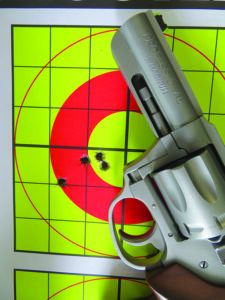
As you can imagine, we saw a range of velocities in both the 32-caliber cartridges and the 38-caliber loads. We also saw differences in point of impact when using the same aiming point. The slower-moving lower-velocity bullets grouped higher than the faster-moving higher-velocity bullets. The reason for this is the inherent design of the revolver. Revolvers have a high center bore axis from the shooter’s grip; because of this, there is more muzzle flip with revolvers. As the shot is fired, the muzzle flips up. With slower-velocity ammo, the bullet takes longer to exit the barrel, and when revolver flips up, the bullets impact higher. Use the same aim point with the faster-velocity ammo, and you will see the faster bullets’ impact at point of aim. The same physics apply, except the bullets from the faster ammo travel quicker through the barrel as the muzzle is just beginning to flip up, so bullets print to point of aim. The rule of thumb with revolver loads is to aim low with slower-velocity ammo when the revolver is sighted in for magnum faster-velocity ammo. Depending on the load, we saw as much as 4 to 6 inches difference in point of impact between slow and fast ammo.
Looking at the data between the 80- and 100-grain 32 H&R Magnum and the 110-grain 38 Special +P, the 32 H&R Magnum had a slight edge in velocity and muzzle energy. The Buffalo Bore 32 H&R Magnum +P had an average velocity of 1100 fps and average muzzle energy of 325 foot-pounds, while the 38 Special +P Hornady Critical Defense with a 110-grain FTX bullet had an average velocity of 957 fps and average muzzle energy of 224 foot-pounds. So the 32 H&R Magnum had about 140 fps more velocity and 100 foot-pounds more muzzle energy. Recoil felt similar between 32 H&R Magnum and 38 Special +P. The non +P ammo also showed the Hornady Critical Defense in 32 H&R Magnum had about a 230 fps increase in muzzle velocity over the Speer and Armscor 38 Special ammo. So it is clear, the 32 H&R Magnum has an edge in velocity and energy over some 38 Special loads. Comparing the 32 S&W Long to the 38 Special, the 38 was pushing heavier bullets at nearly the same velocity.
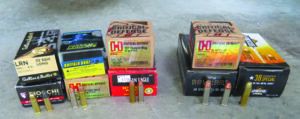
Looking at the 327 Federal Magnum, the game really changed. American Eagle rounds with 100-grain bullets, compared to the Hornady Critical Defense 38 Special +P with a 110-grain bullet, the 327 sizzled along nearly 400 fps faster. The Hornady Critical Defense in 327 Federal Magnum was loaded with an 80-grain FTX bullet and had a muzzle velocity of 1334 fps. Another fast, hot load. There was a notable increase in recoil, but the heavy Ruger with the rubber grip slurped it up and made it very tolerable. Looking back at data from 357 Magnum tests with revolvers with 2- to 3-inch barrels, we discovered the 357 Magnum was pushing heavier bullets at slightly less velocity than the 327 Federal Mag. In fact, the 327 Federal Magnum acts a lot more like a 9mm +P, and that is serious velocity and energy. So we can safely say the 327 Federal Magnum does give the 357 Magnum a run for its money and acts a lot like a 9mm +P, and it does it with less felt recoil in small, compact revolvers. As you can see, we started to warm up to the 32 Magnums.
(Remember to clean these revolvers often because carbon and lead — depending on the bullet type— from shorter 32 S&W Long cartridges can cause the long magnum case to bind in the chambers.)
We tested for bench accuracy at targets set at 15 yards and fired SA mode to squeeze out the best groups. Our targets were Trouble Shooter 4- and 6-inch bullseyes from Thompson Target. These targets offer advice on why bullets are grouping in certain places on the target due to shooter error. We also fired for speed at 15 yards and at 25 yards, bouncing pine cones in front of the dirt berm. Once we got our dope on where the ammo would impact, we had some low-recoil fun with the 32s and the 38. We won’t be trading in our 357 Mags, but we did appreciate the 32 revolvers and found a new 38 to like. Here’s what else we found.
Gun Tests Grade: A-
$420
In our opinion, the Charter Arms Professional checks all the right boxes for the argument to own a 32 Magnum revolver. It offers good sights, light weight, a nice smooth grip, seven-shot capacity, and decent accuracy. Plus, it has the ability to fire 32 S&W Long and 32 H&R Magnum ammo. What’s not to like? Let’s start with the trigger.
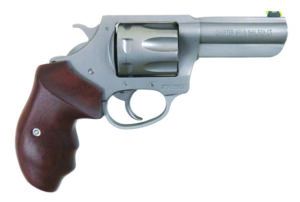
| Action Type | Revolver, double or single |
| Overall Length | 8.0 in. |
| Barrel Length | 3.0 in. |
| Barrel Twist Rate | 1:16 in. RH |
| Sight Radius | 4.5 in. |
| Overall Height | 5.0 in. |
| Maximum Width | 1.4 in. |
| Weight Unloaded | 22.0 oz. |
| Weight Loaded | 23.5 oz. |
| Cylinder Gap | 0.001 in. |
| Capacity | 7 |
| Frame Material/Finish | Stainless/matte stainless |
| Barrel/Cylinder Material/Finish | Stainless/matte stainless |
| Frame Front Strap Height | 2.6 in. |
| Frame Back Strap Height | 3.3 in. |
| Grip | Smooth finger grooves wood |
| Grip Thickness Maximum | 1.1 in. |
| Grip Circumference Maximum | 4.8 in. |
| Front Sight | Post green fiber optic |
| Rear Sight | Fixed notch |
| Trigger Pull Weight (DA) | 12+ lbs. |
| Trigger Pull Weight (SA) | 4.2 lbs. |
| Trigger Span (DA) | 3.0 in. |
| Trigger Span (SA) | 2.6 in. |
| Safety | Internal transfer bar |
| Warranty | Limited lifetime warranty |
| Telephone | (203) 922-1652 |
| Website | CharterArms.com |
| Made In | U.S.A. |
The trigger is typical Charter Arms, meaning it is gritty and smooths up with use. When we first acquired the Professional, we dry-fired the revolver until our trigger finger ached, then used our support hand until the support-hand trigger finger ached. Suffice to say, we dry-fired the Professional a lot. We did notice we could easily short-stroke the trigger at first, meaning we did not allow the trigger to move fully forward. It was user error, but we did not have any issues short-stroking the Ruger or Taurus. The Charter Arms trigger finally smoothed up, and the mechanism felt less gritty.
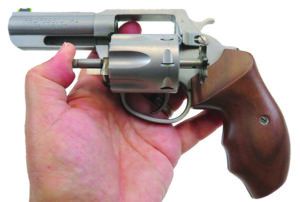
So what did we like about the Professional? Nearly everything else. The revolver is light weight, only 22 ounces unloaded, and has a nice balance in hand with the 3-inch barrel. The full lug was rounded so it made the Professional easier to holster. The front sight consists of a green fiber-optic pipe that glows in light. It is much dimmer in the dark. There is also plenty of room between the front sight fitting into the rear notch. This sight is fast to acquire. We rested the bottom edge of the fiber optic pipe on the bottom of the notch. The rear sight is cut into the frame to reduce glare.
The seven-shot cylinder gives the Professional the highest capacity of the revolvers tested. Props to Charter Arms for fitting seven chambers in the cylinder without increasing the diameter of the cylinder. We noted the gap between the front of the cylinder and the forcing cone was 0.001 inch. This is a close tolerance, so if we owned this revolver, we would be diligent in cleaning the carbon and lead, especially if we shot lead-bullet 32 S&W Longs. That would reduce the chance of the cylinder binding.
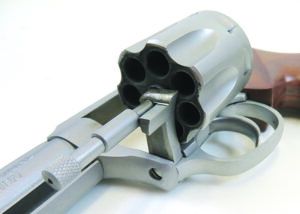
The crane fits into the frame similar to a Ruger LCR, locking the front of the cylinder. The ejector pin locks the rear of the cylinder via a hole in the center of the recoil shield. The cylinder had a bit of wiggle. The fit and matte stainless finish were good. The smooth wood grip has finger grooves, a thumb rest, and slight palm swell. We though it was a good-fitting grip, and we found the lack of texture on the grip was not a liability. Another small complaint is that the hammer spur left a dent in the top edge of the wood grip when we cocked the revolver for SA mode. Overall, this a nice-looking revolver, and it felt good in hand.
The trigger is wide and smooth and no doubt helps make the 12+ pound DA pull feel less. The SA pull weight is a very crisp 4.2 pounds. The hammer spur is wide and secure when cocking it back with a thumb.
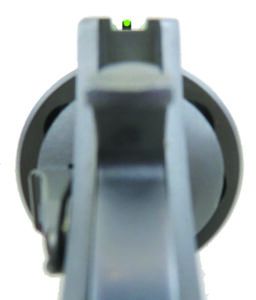
During accuracy testing, our best five-shot group with S&W Long ammo measured 1.33 inches with Fiocchi 97-grain FMJ. The 32 S&W Long Sellier & Bellot 100-grain LFN gave us a best group of 1.59 inches. We noted the Charter Arms had, on average, a 40-fps velocity increase compared to the Ruger when shooting the same ammo. The 32 S&W Long ammo averaged 836 fps to 796 fps muzzle velocity. The Professional showed its stuff when we moved up the velocity ladder to the Hornady Critical Defense loaded with an 80-grain FTX bullet. This load amped up the speed to 1049 fps. Our best group measured 0.71 inch. Nice. The 32 H&R Magnum +P by Buffalo Bore was even faster at 1264 fps muzzle velocity. The Buffalo Bore load used a 100-grain JHP, and our best group measured 1.09 inches. The groups definitely shrank with the 32 H&R Magnum loads and averaged 0.99 to 1.30 inches. We noticed a difference in recoil when switching from the 32 S&W Long to 32 H&R Mag. We also noted the slower 32 S&W Long ammo printed higher than the 32 H&R Magnum ammo when using the same aiming point and at the same distance. For speed shooting, we found the 32 Magnum load was easy to control compared to a hot 38 Special or 357 Mag. We bounced around a large pine cone at 20 yards and found we enjoyed shooting the compact revolver. The Charter Arms windage point of aim was dead on, and that is important in a fixed-sight revolver. The Professional did not fully eject cases.
Our Team Said: We liked the Professional and would load it with the Buffalo Bore +P ammo for defense. The trigger eventually smoothed out and we liked the seven-shot capacity. The green-dot fiber-optic pipe was easy to acquire. Buy this affordable revolver if you must have a 32 Magnum, which is not a bad idea with the current shortage of 38 Special.
32 S&W Long Range Data
| Ruger SP101 | Sellier & Bellot 100-gr. LFN | Fiocchi 97-gr. FMJ |
| Average Velocity | 798 fps | 753 fps |
| Muzzle Energy | 141 ft.-lbs. | 122 ft.-lbs. |
| Smallest Group | 0.44 in. | 0.74 in. |
| Average Group | 0.79 in. | 0.85 in. |
| Charter Arms Professional | Sellier & Bellot 100-gr. LFN | Fiocchi 97-gr. FMJ |
| Average Velocity | 836 fps | 793 fps |
| Muzzle Energy | 155 ft.-lbs. | 135 ft.-lbs. |
| Smallest Group | 1.59 in. | 1.33 in. |
| Average Group | 1.77 in. | 1.45 in. |
32 H&R Magnum Range Data
| Ruger SP101 | Hornady Critical Defense 80-gr. FTX | Buffalo Bore 100-gr. JHP +P |
| Average Velocity | 1003 fps | 1166 fps |
| Muzzle Energy | 179 ft.-lbs. | 302 ft.-lbs. |
| Smallest Group | 0.46 in. | 1.54 in. |
| Average Group | 0.71 in. | 1.99 in. |
| Charter Arms Professional | Hornady Critical Defense 80-gr. FTX | Buffalo Bore 100-gr. JHP |
| Average Velocity | 1049 fps | 1264 fps |
| Muzzle Energy | 196 ft.-lbs. | 355 ft.-lbs. |
| Smallest Group | 0.71 in. | 1.09 in. |
| Average Group | 0.99 in. | 1.30 in. |
327 Federal Magnum Range Data
| Ruger SP101 | Federal American Eagle 100-gr. SP | Hornady Critical Defense 80-gr. FTX |
| Average Velocity | 1425 fps | 1334 fps |
| Muzzle Energy | 451 ft.-lbs. | 316 ft.-lbs. |
| Smallest Group | 1.50 in. | 1.96 in. |
| Average Group | 1.67 in. | 2.08 in. |
| Taurus 856 Defender | Armscor 158-gr. FMJ | Speer Gold Dot 125-gr. GDHP | Hornady Critical Defense 110-gr. FTX +P |
| Average Velocity | 789 fps | 791 fps | 957 fps |
| Muzzle Energy | 218 ft.-lbs. | 174 ft.-lbs. | 224 ft.-lbs. |
| Smallest Group | 1.60 in. | 1.27 in. | 1.14 in. |
| Average Group | 1.70 in. | 1.65 in. | 1.33 in. |
Value Guide: Short Revolver Rankings
| GUN NAME | ISSUE | GRADE | COMMENTS |
|---|---|---|---|
| Smith & Wesson Model 351 PD 160228 22 WMR, $766 | Apr. 2021 | A | The M351 offers light weight, 7-shot capacity, and a bright Hi-Viz fiber-optic front sight that we really liked. |
| Ruger Model LCRx 5439 22 WMR, $599 | Apr. 2021 | A- | Light weight, great grip, good accuracy. DA trigger pull was very heavy. Would havliked more capacity. |
| Taurus Model 942 2-942M029 22 WMR, $309 | Apr. 2021 | B | 8-shot capacity. Heavy, so concealability in a pants pocket is not practical. Trigger was heavy. |
| Smith & Wesson PC Model 986 10227 9mm Luger, $1129 | Mar. 2021 | A | All-business, made-to-perform revolver that offered excellent accuracy with Hornady Critical Duty ammo. |
| Rock Island Armory AL9.0 9231B 9mm Luger, $599 | Mar. 2021 | A | Offered good accuracy and shooting comfort due to the full-size grip. Aesthetics are not its strong point. |
| Taurus Tracker 692 2-692039 9mm/38 Sp./357 Mag., $705 | Mar. 2021 | A- | Offers a lot of versatility with the extra cylinder assembly. The price is reasonable. |
| Colt King Cobra KCOBRA-SB3BB 357 Magnum, $838 | May 2020 | A | A 357 Magnum powerhouse. Offers good performance with the 3-inch barrel and is well made. |
| Rock Island Armory AL3.0 357 Magnum, $504 | May 2020 | A- | Good price, accuracy, shooting comfort. Not a beautiful revolver for sure, but it did provide performance. |
| Rossi Model 971 VRC 357 Magnum, $295 | May 2020 | B | Great trigger, and the porting helped keep us on target. Accuracy was less than stellar. |
| Ruger LCRx 5435 22 LR, $470 | Apr. 2020 | B+ | The LCRx is lightweight and would make a nice kit gun if that were the only considertion. Cost is too high. |
| Smith & Wesson Model 637-2 163050 38 Special +P, $389 | Dec. 2018 | A | Consistent trigger pull, DA or SA trigger mode, recoil absorbing grip, and lightweight. |
| Taurus 856 Model 2-856021 38 Special, $278 | Dec. 2018 | A- | Consistent trigger in double-action or single-action mode, a small grip, and it offers six shots. |
| Smith & Wesson M&P Bodyguard 38 103039 38 Sp +P, $348 | Dec. 2018 | A- | Easily concealable and lightweight. The DAO trigger pull was smooth. Offers only five shots. |
| Smith & Wesson Model 317-3 Kit Gun 22 LR, $759 | May 2018 | A- | The 317-3 Kit Gun had a good trigger and grip size. The front sight was easy to see for informal plinking. |
| Charter Arms Pathfinder Lite Model 72224 22 LR, $365 | May 2018 | B | Had a great grip size, but the double-action trigger was too stiff, and it shot to the left for some testers. |
| Ruger LCRx Model 5460 357 Magnum, $669 | Apr. 2018 | A- | Had decent accuracy and made concealed carry uncomplicated. Transmitted a lot of recoil to the hand. |
| Kimber K6s Model CDP 357 Magnum, $1155 | Apr. 2018 | B+ | Has a smooth, consistent trigger pull, small grip, and offers six shots. The price caused us to recoil. |
| Colt Cobra COBRA-SM2FO 38 Special, $699 | Apr. 2018 | B | The Cobra had a good trigger pull in double action and good sights, which made it easy and accurate to shoot. |
| Charter Arms Boomer 74429 44 Special, $443 | Apr. 2018 | B- | The Boomer was difficult to shoot at distance due to the lack of sights. A laser grip would enhance it. |
| Ruger GP100 1761 44 Special, $649 | Jan. 2018 | B | Many of the raters liked shooting the Ruger GP100 the most. |
| S&W M69 Combat Magnum 10064 44 Sp./44 Mag., $732 | Jan. 2018 | B- | Has much merit for personal defense when loaded with 44 Specials or 44 Magnums. |
| Smith & Wesson M649 357 Magnum, $500-$530 | Jun. 2017 | A | The 649 was lightweight, thin, and concealable. Even with 357 Magnum loads, recoil was tolerable. |




























I had a Ruger SP-101 in .327 Magnum. After 200 rounds the frame cracked. Ruger replaced it with a .38 special.
Hello,
My Ruger SP101 in .327 Magnum was fun to shoot, but feel victim to a theft ring in Atlanta a few years back….800+ guns stolen in a very short period. About to try the Charter Arms .32 H&R mag.
Charter Arms Professional IV 32 H&R Magnum Revolver model # 73230 does it come in a 4″ barrel and
Can I use 32sw short ammo with this firearm?